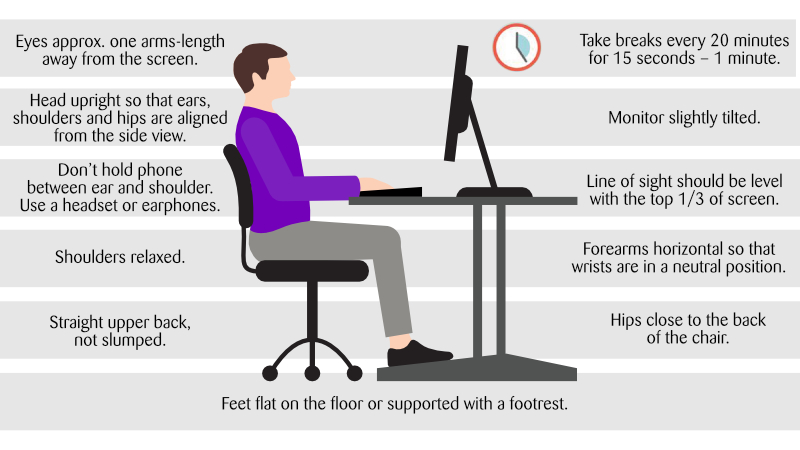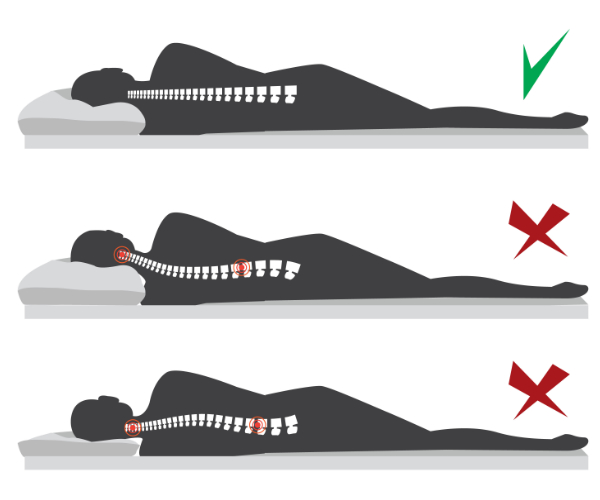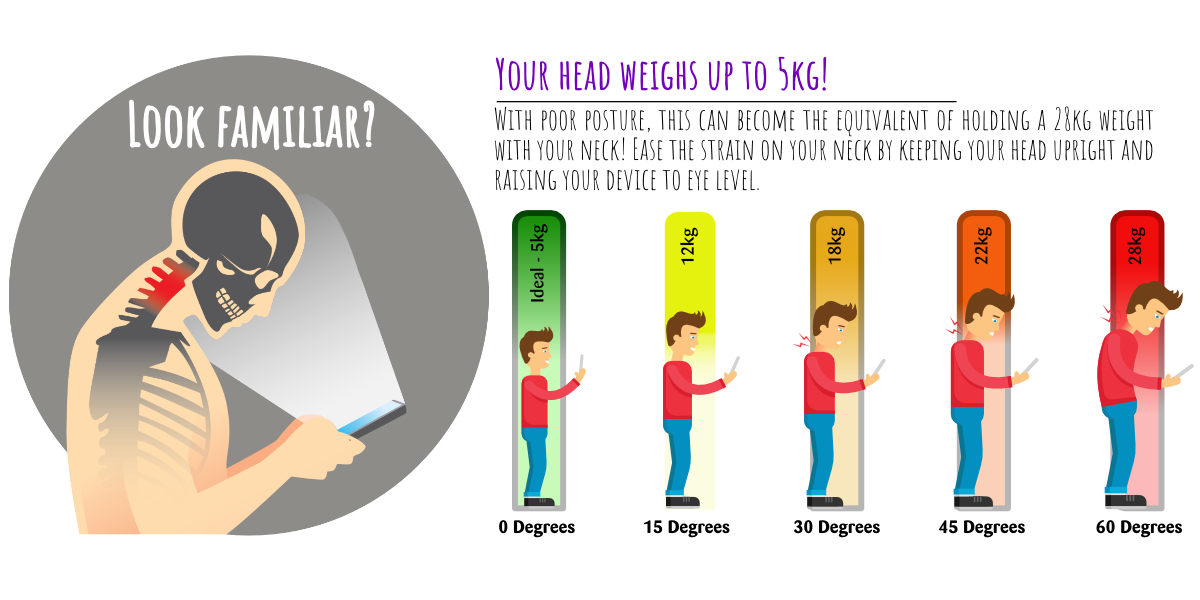
A modern issue…
As we spend more time using devices, or working in spaces not necessarily set up for computer use (like the kitchen bench!), we are seeing more and more people begin to develop a forward head carriage and lower neck ‘hump’, which can be caused by repetitively putting strain on your neck from poor technology habits.
Why is posture so important?
The proper positioning of your body whilst sitting, standing and sleeping is important for several reasons. Balanced posture ensures that there are minimal and equal amounts of stress on all joints and supporting ligaments, tendons and muscles. Poor posture may be visually unappealing, but more importantly it can lead to chronic discomfort, fatigue, headaches, more injuries, degenerative arthritis, nerve dysfunction, digestive problems and breathing difficulties.
Workstation Posture
With many jobs, extended periods seated at a desk are simply part of the role. Practising good posture, and ensuring you have regular movement breaks can help you avoid aches and pains and headaches, as well as damage to your spine.
Sit with your feet flat on the floor or footrest with your knees and hips bent to 90 degrees. Roll your shoulders backwards and then down. Your pelvis should be rocked forwards rather than backwards. Your ears should be in line vertically with your shoulders, which are also in line with your hips. If you are in front of a computer or an electronic device, the screen should ideally be at eye-level to avoid putting strain on neck and shoulder muscles. To help keep your shoulders back, stretching your pectoral muscles and strengthening your rhomboid (shoulder blade) muscles can help. Avoid extended periods of sitting or crossing your legs.

Sleeping Posture
With a third of our lives spent in bed, an incorrect sleeping position can have a significant impact on our spine, resulting in waking with a sore neck or back. Nerves irritated by subluxations caused during sleep can also result in headaches and migraines as well as interrupted sleep – causing fatigue through lack of decent rest. The best sleeping position for your spinal health is on your side. This allows your body to keep the neck and spine in a straight line. Sleeping on your stomach can be very harmful to your spine since it forces you to crank your head to the side, causing neck pain and stiffness. It is also important to use a pillow that promotes the natural shape of your spine and neck. For side sleepers, try a thicker pillow to keep your head and neck held steady between your shoulders. For those who sleep on their back, choose a pillow that doesn’t prop your head up too high. This can disrupt the natural curve of your neck. Talk to your chiropractor if you have questions.

Driving Posture
To keep your pelvis balanced whilst driving, lift your hips up off the seat when you first get in to re-align your pelvis to be square-on to the steering wheel. Avoid sitting on your phone or wallet. Sit up straight with your shoulders relaxed, then adjust your rear-vision mirror to see clearly. The next time you get in, adjust your body position rather than your mirrors.
Dr Emma shares more tips about achieving the perfect driving posture!
Mobile Devices
With the use of electronic devices increasingly dominating our day, it is no surprise that the effects of poor posture (headaches, migraines, neck and shoulder strains and spinal degeneration) are also becoming increasingly common. Whether it’s a phone, tablet or computer, it’s common to have the head forward of the shoulders and looking downward, which also brings the shoulders into a rounded position. This places a huge amount of strain on the spine and supportive muscles. It is vital to ensure that while using a mobile phone, tablet or laptop that the device is kept at eye level. The same also goes while reading books. Using a cushion or a stack of magazines can help to prop up the height of your book or device. Regular breaks to stretch the neck will also help.


Our short video explains the strain we inflict on our neck with incorrect posture while using a device
Standing Posture
Good posture is not only while you are seated! When you are standing, try to imagine observing yourself side-on. Your shoulders, hips and ankles should all be aligned vertically, with your spine upright and your shoulders pulled back and down. Your feet should be shoulder-width apart, with ‘soft-knees – not locked.


